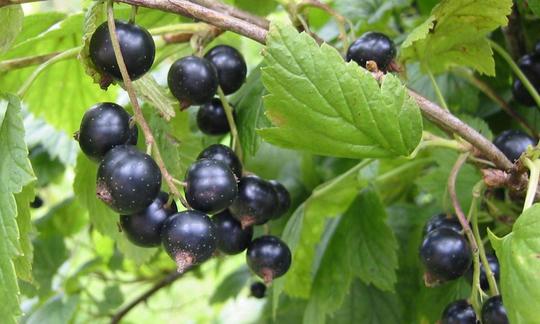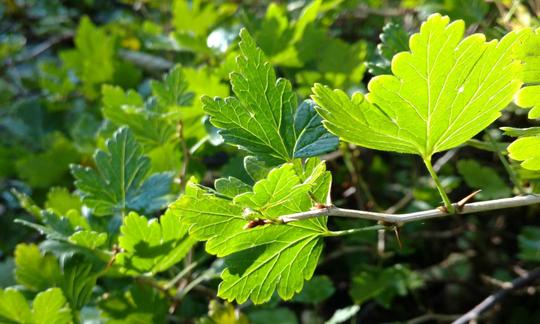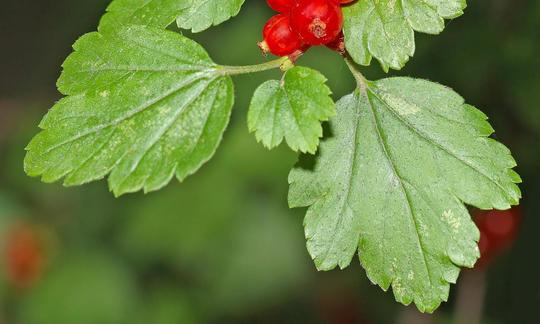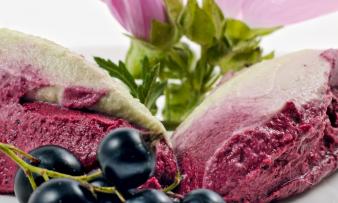Table of contents
The leaves of the black and red currants ( Ribes nigrum and Ribes rubrum ) can be used as a tasty ingredient in the kitchen. Black currant leaves, which are recognized as medicinal plants, help with mild aching limbs and minor urinary tract problems.
Use in the kitchen:
Young blackcurrant leaves are rich in protein and have a slightly mushroomy, refreshing, bitter-sour taste. The chopped leaves are used as an addition to raw salads, in soups, as a vegetable filling (e.g. in dumplings) and fresh or dried for herbal teas. The leaves of the blackcurrant smell of cassis and are considered to have a more intense flavour than those of the redcurrant.
Blackcurrant leaves used to be an important substitute for black and green tea. "A perfectly drinkable English 'tea' can be prepared using hawthorn, sage , lemon balm , woodruff and blackcurrant leaves as flavourings. If blackcurrant and sage predominate, it will taste somewhat like Ceylon tea" (Dorothy Hartley, Food in England, 1954). 1
Other edible components are the flower buds ( Ribes nigrum ), the flowers that are just opening and of course the black currants or the red and white currants (Ribisel) .
Recipe for vegan blackcurrant mousse with mallow flowers:
First, pluck the stems from 250 g of blackcurrants. Puree the stems together with 2 tablespoons of coconut butter , 4 dates , 75 g of drinking water and the juice of half a lemon . Put the resulting green cream (mousse) in a bowl and refrigerate until the surface is slightly firm.
Then puree the blackcurrants with another 4 dates, 3 tablespoons of coconut butter, 10 g of mallow flowers and 75 g of drinking water. Pour the purple cream onto the green cream and place the layered mousse in the fridge for about an hour.
The cream should be firm enough to cut out small dumplings. The dumplings can be arranged on plates and decorated with berries and flowers. You can find the full recipe for this vegan raw food mousse HERE .
Recipe for blackcurrant leaf tea:
To make a tea from blackcurrant leaves, pour boiling water over 2-4 g (daily dose = 6-12 g) of the finely chopped medicinal herb. Alternatively, you can put the leaves in a cold brew and bring them to the boil briefly. Cover and let the tea steep for 5-10 minutes before straining it through a tea strainer. Drink a cup of this several times a day. 2
For urinary tract problems, you can use a bladder and kidney tea, which contains a combination of medicinal plants such as orthosiphon leaves, restharrow root, goldenrod, birch leaves or nettle leaves . 3,4
A mixture of blackcurrant leaves, raspberry leaves, blackberry leaves , rose hips, marigold blossoms and bitter orange peel is suitable as a home tea. 5
| Not only vegans or vegetarians should read this: Vegans often eat unhealthily. Avoidable nutritional mistakes . |
Purchasing - where to buy?
Blackcurrant leaves are often included in tea blends, e.g. herbal teas, house teas, family teas, cold teas, urine teas or health teas. Ready-made blends with blackcurrant leaves can be found in drugstores. The cut and dried leaves can be purchased in single varieties in pharmacies or online.
The blackcurrant leaves available in stores mostly come from Poland, Hungary and Romania. 3,2
We have not yet found any tea with blackcurrant leaves in supermarket chains such as Coop , Migros , Denner , Volg , Spar , Aldi , Lidl , Rewe , Edeka or Hofer as well as in the organic supermarkets Denns and Alnatura .
The German Drug Codex ( DAC ) specifies the required quality of blackcurrant leaves. 3 According to the European Pharmacopoeia (Ph. Eur. 9), Ribis nigri folium (or plural: Ribis nigri folia) is the name for dried and whole or cut leaves of Ribes nigrum L. - with a minimum flavonoid content of 0.8%, calculated as hyperoside. 6
As a traditional herbal medicine, the leaves are also used in powder form, as a dry extract or in solid form (e.g. as tablets). 7 The collection (harvest) takes place according to the pharmacopoeia requirements during or shortly after the flowering period. The drying takes place in the air outdoors or in drying facilities at a maximum of 60 °C. 6
Blackcurrant leaf tinctures (Black Currant) are available as Folia Ribis nigri tinctura in pharmacies and drugstores.
Since the clinical and pharmacological data on blackcurrant leaves are currently insufficient, there is no finished medicinal product with a defined indication on the market. 2
Found in the wild - Season:
Blackcurrants occasionally grow wild in Central and Eastern Europe. 2 The wild plant prefers moist to wet, nutrient-rich, boggy and clayey soils. 8 Main areas of distribution are humus-rich deciduous and alluvial forests (alluvial forests), moist forests and bushes, and alder groves. 5,9,10
The black currant grows as a 1-2 meter high, aromatic shrub without thorns. The edges of the three to five-lobed leaves are coarsely serrated and have oil glands on their underside. The flowers, arranged in hanging clusters, are yellowish-green and have a brownish-red edge. The black berries are round and have many seeds, with a diameter of one centimeter. 1.10
When do blackcurrants start to bloom? Season : The main flowering period of blackcurrants is from April (or early May) to the end of May. The leaves are harvested during or shortly after the flowering period from April to June. 5,6,9,10
When harvesting, make sure to only collect leaves that are not affected by fungal infections (e.g. mildew, columnar rust). Red to orange pustules can appear on leaves affected by columnar rust. Mildew is indicated by a white-gray coating on the leaves. Blackcurrants are rarely affected by leaf fall disease. The leaves first develop brown spots, begin to curl, roll up and finally fall off. Red pustule disease, also caused by fungi, is indicated by bumps on the bark and by the leaves slowly wilting and falling off. 11
Storage:
The dried leaves (black and red J.) should be stored in a dry place and protected from light. 2 Suitable containers for storage are metal cans, sealable paper bags with aroma protection or dark glass jars with screw caps. Fresh leaves can be air-dried in a place protected from the sun.
Ingredients - nutritional value - calories:
The leaves of the black currant contain 0.5-1.2% flavonoids - especially derivatives of quercetin (at least 1% as isoquercitrin, at least 0.8% as hyperoside and an undefined proportion as isorhamnetin glycosides) - as well as kaempferol (kaempferol), delphinidin and proanthocyanidins (procyanidins). 2.9
Blackcurrant leaves also contain precursors of tannins, phenolic acids or phenolcarboxylic acids (caffeic acid, chlorogenic acid, neochlorogenic acid, protocatechuic acid, etc.), essential oils, diterpenes, polyunsaturated fatty acids ( omega-3 fatty acids, α-linolenic acid, alpha-linolenic acid, linolenic acid, ALA and omega-6 fatty acids, linoleic acid, LA ) 2,9 and vitamin C. 10
Health aspects - effects:
In its assessment of blackcurrant leaves, the Committee on Herbal Medicinal Products ( HMPC ) took into account laboratory studies on rats and mice. There are currently no clinical studies on patients. Recognition as a herbal medicinal product for "traditional use" means that its effectiveness is nevertheless plausible and that it has been used safely for at least 30 years (including at least 15 years within the EU ).
Laboratory studies show anti-inflammatory effects of blackcurrant leaf extracts, which are due to the flavonoids. Another effect is the inhibition of cell and tissue growth. In addition, an antiviral effect of the leaf extract against the influenza virus A was proven. 2,12
Herbal preparations containing blackcurrant leaves have a weak saluretic effect (excretion of salt via the kidneys into the urine), a diuretic effect (water pill) and, in animal experiments, a blood pressure lowering effect. 4
Dangers - Intolerances - Side effects:
At the time of the evaluation by the Committee for Herbal Medicinal Products ( HMPC ), no side effects of blackcurrant leaves were known. Likewise, no case of overdose has been reported to date. 4,7 A contraindication is given in case of hypersensitivity to the active ingredients. 7,13
The safety of the application during pregnancy and breastfeeding has not yet been proven. Due to a lack of or insufficient data, the HMPC does not recommend the application during pregnancy and breastfeeding or in children and adolescents under 18 years of age. 7
Patients who are advised to drink less fluids, e.g. in cases of severe heart and kidney disease, should not take medicines containing blackcurrants. 13
Use as a medicinal plant:
The Committee for Herbal Medicinal Products ( HMPC ) has classified blackcurrant leaves as a traditional herbal medicinal product. Based on many years of experience, blackcurrant leaves can be used for mild aching limbs and as a supportive treatment for minor urinary tract complaints (inflammations). The leaves increase the amount of urine and thus flush the urinary tract (kidneys, bladder). 2,3,7,13
To ensure an increase in urine output, adequate fluid intake is required during treatment. 7
If you have pain in your limbs, you can take a tea made from blackcurrant leaves three times a day. As a single dose, use 2-4 g of crushed leaves in 200 ml of boiling water. The daily dose is 6-12 g of the herbal substance. 7
For urinary tract complaints and joint pain, a single dose of 170 mg of dry extract can be dissolved in water (7:1). The preparation is taken one to three times a day. The daily dose is 170-510 mg. The powdered leaf substance is taken three to five times a day. The single dose is 340 mg and the daily dose is 1,020 to 1,700 mg. 7
In principle, the intended use does not require medical supervision. 13 However, if the symptoms persist for more than two weeks (urinary tract problems) or four weeks (limb pain) while using the medicine, the HMPC recommends consulting a doctor in its " European Union herbal monograph on Ribes nigrum L., folium". 7
According to ESCOP ( European Scientific Cooperative on Phytotherapy ), blackcurrant leaves can be taken to help with rheumatic complaints. 2,3 Use 20-50 g of blackcurrant leaves in one liter of water. Allow to brew for 15 minutes. Drink 250-500 ml of this preparation per day. Take 5 ml of the liquid extract (1:1) twice a day before meals. This dose for adults also applies to seniors. 4
Folk medicine - natural medicine:
Since currants became known in Northern Europe in the 16th century, the medicinal plant has been used as a diuretic. 2 Peter Forestus ( Petrus Forestus ), who treated urinary retention and bladder stones with currant leaves, was probably the first to describe the medicinal properties of the leaves. 1
Today, in addition to the uses mentioned by HMPC and ESCOP , the leaves of the blackcurrant are used for gout, kidney stones, arthritis, dropsy, diarrhea and, rarely, externally for wound treatment. The leaves can be applied fresh or crushed to insect bites and wounds. 2,5,9
After taking curative blackcurrant leaf tea, rheumatism and gout attacks may become less frequent and less severe. 10
A tea made from red currant leaves can have a positive effect on the internal organs (stomach, liver, lungs, bladder). In traditional medicine, it is used to purify the blood and treat arteriosclerosis. 9
Occurrence - Origin:
The original home of the black currant is thought to be the European-Asian forest area. 10 Since natural and wild occurrences are often indistinguishable, the natural distribution can no longer be reconstructed. 8
According to Wikipedia , the genus of currants ( Ribes ) is found worldwide in around 140 to 160 species. Currants are found primarily in temperate climate regions of the northern hemisphere. 14 Black currants are found in the north as far as Lapland and in the south as far as Armenia and the Himalayas. 5,8
Red and white currants originate from the European varieties Ribes rubrum , Ribes vulgare , Ribes petraeum and Ribes multiflorum , while black currants originate from Ribes nigrum . 15
Growing in the garden or as a potted plant:
Which location for currants? The ideal soil for the shallow-rooted currants is permeable, fertile, clayey and slightly acidic. Other important location criteria are a sunny to partially shaded and wind-protected location. Before planting the bushes, the condition of the topsoil can be improved with compost, as the plant has a high need for humus and nutrients. 1,15,16
The hardy shrub needs to be protected from cold winds and late frosts during the flowering period. If you want to grow the plant in areas with frequent late frosts, you can plant the currant bush as a mobile pot plant. 15
In autumn, one third of the older (grey and black) canes are removed. A strong winter pruning improves the length of the grapes and the size of the berries and thus the picking performance. How long does a currant bush live? The bush should be replaced every ten years, as it loses its vigor over time. Propagation is possible using cuttings. 1.15
Cultivation - Harvest:
Only recently have currants been cultivated on a commercial scale. Before that, for centuries, the cultivated plants hardly differed from the wild species. Most of the cultivated varieties in use today were developed by breeders and research institutes after the Second World War due to food shortages. 1
Important producing countries are Poland, Hungary, Romania, France and the Netherlands. 6
Animal protection - species protection - animal welfare:
Hymenoptera swarm particularly heavily around the inconspicuous flowers of currants. The nectar value of the flowers is high and the pollen value medium (nectar value and pollen value scale: none, low, medium, high, very high). Currants serve as food for insects mainly in April and May (early summer nectar). The nectar value is understood to be the entire food supply of a flower for insects, i.e. nectar, pollen and honeydew. 17
General information:
In addition to the gooseberry ( Ribes uva-crispa ), black currants ( Ribes nigrum ) and red or white currants ( Ribes rubrum ) also belong to the currant genus ( Ribes ). Currants ( Ribes ) are the only plant genus in the gooseberry family ( Grossulariaceae ). 8,14
The origin of the name is due to the ripening time around St. John's Day on June 24th. 3
Alternative names:
Common names for the leaves of the currant are blackcurrant leaves, bockberry leaves, goutberry leaves and bugberry leaves.
In English, the leaves of the black currant are called black currant leaves.
Literature - Sources:
Bibliography - 17 Sources
| 1. | Bown D. Kräuter - Die grosse Enzyklopädie: Anbau und Verwendung. 2. Auflage. München; 2015. Dorling Kindersly Verlag GmbH. |
| 2. | Blaschek Wolfgang (Herausgeber). Wichtl – Teedrogen und Phytopharmaka. Ein Handbuch für die Praxis. 6. Auflage. Stuttgart; 2016. Wissenschaftliche Verlagsgesellschaft mbH. |
| 3. | koop-phyto.org Johannisbeere. |
| 4. | Schilcher H., Kammerer S., Wegener T. Leitfaden Phytotherapie. 3. Auflage. München; 2007. Elsevier GmbH. |
| 5. | Niederegger, Oswald; Mayr, Christoph. Heilpflanzen der Alpen. Gesundheit aus der Natur von A bis Z. Innsbruck; 2006. Tyrolia-Verlag. |
| 6. | medizinalpflanzen.de Schwarze Johannisbeerblätter - Ribis nigri folium [DAC 2004]. |
| 7. | ema.europa.eu (European Medicines Agency). Final European Union herbal monograph on Ribes nigrum L., folium. HMPC Committee on Herbal Medicinal Products. PDF. |
| 8. | Wikipedia Schwarze Johannisbeere. |
| 9. | Fleischhauer SG, Guthmann J, Spiegelberger R. Enzyklopädie essbare Wildpflanzen. 1. Auflage. Aarau; 2013. AT Verlag, S. 145. |
| 10. | Pahlow Pahlow, M: Das grosse Buch der Heilpflanzen. Gesund durch die Heilkräfte der Natur. 8. Auflage. Hamburg; 2019. Nikol Verlagsgesellschaft mbH & Co. KG. |
| 11. | gartenlexikon.de 6 Krankheiten bei Johannisbeeren erkennen und bekämpfen. |
| 12. | Erhardt C. et al. A Plant Extract of Ribes nigrum folium Possesses Anti-Influenza Virus Activity In Vitro and In Vivo by Preventing Virus Entry to Host Cells. |
| 13. | ema.europa.eu (European Medicines Agency). Blackcurrant leaf: Summary for the public. PDF. |
| 14. | Wikipedia Johannisbeeren. |
| 15. | hortipendium.de Johannisbeere. |
| 16. | awl.ch Schwarze Johannisbeere – Ribes nigrum. |
| 17. | Kremer, Bruno P. Mein Garten – Ein Bienenparadies. 2. Auflage. Bern; 2018. Haupt Verlag. |










Comments